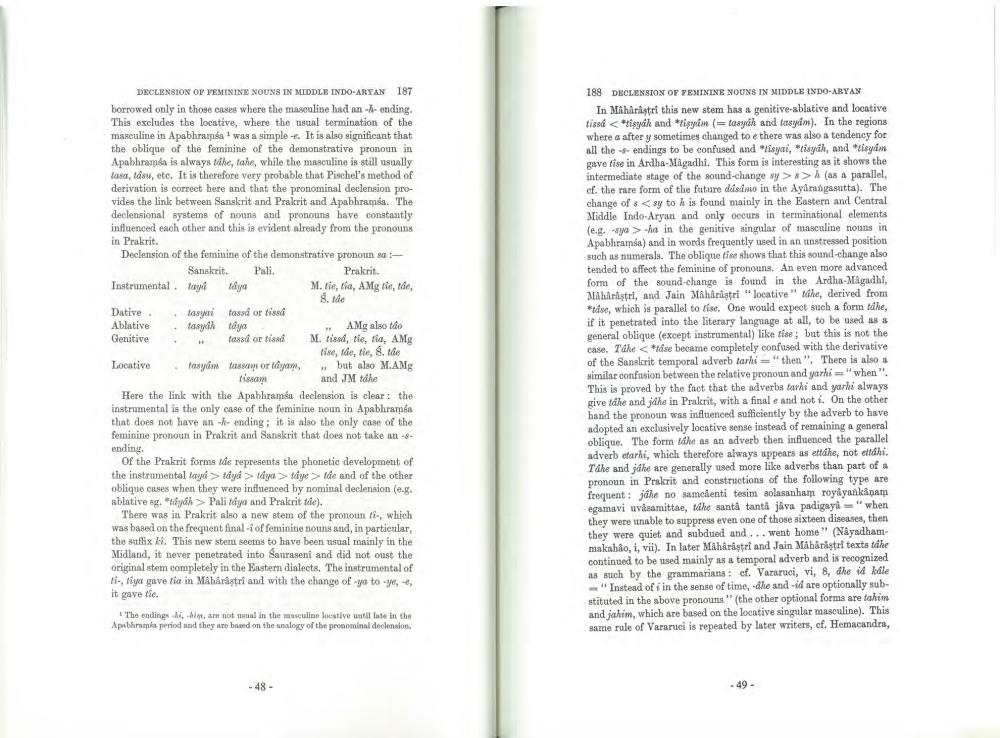________________
DECLENSION OF TEMININE NOUNS IN MIDDLE INDO-ARYAN 187 borrowed only in those cases where the masculine had an -- ending.
This excludes the locative, where the tastal termination of the masculine in Apabhrasa was a simple-t. It is also significant that the oblique of the feminine of the demonstrative pronoun in Apabhrama is always take, tahe, while the masculine is still usually lana, law, etc. It is therefore very probable that Pischel's method of derivation is correct here and that the pronominal declension provides the link between Sanskrit and Prakrit and Apabhrama. The declensional systems of nouns and pronouns have constantly influenced each other and this is evident already from the pronouns in Prakrit. Declension of the feminine of the demonstrative pronoun sa :Sanskrit. Pali.
Prakrit. Instrumental. Bagi ya
M. tie, ta, AMgtie, toe,
8. Ide Dative tasyai fassá or tissa Ablative tasyik täys
AMg also to Genitive -
tassi ortid M. tiesa, tie, tia, AMG
tise, Ilie, tie, Stae Locative tasyam tasys or layam, but also M.AMg
isa
and TM the Here the link with the Apabhramsa declension is clear the instrumental is the only case of the feminine noun in Apabhramsa that does not have an -- ending; it is also the only case of the feminine pronoun in Prakrit and Sanskrit that does not take an -- ending.
Of the Prakrit forms de represents the phonetic development of the instrumental layi> tayo tayaliyet > Ide and of the other oblique cases when they were influenced by nominal declension (e.g. ablative ag, layih > Pali taya and Prakritte).
There was in Prakrit also a new stem of the pronoun tf., which was based on the frequent final-i of feminine nouns and, in particular, the suffix ki. This new stem seems to have been usual mainly in the Midland, it never penetrated into Sauraseni and did not oust the original stem completely in the Eastern dialects. The instrumental of ti, tiyer gave tia in Maharastri and with the change of ye to ye, it gave tic.
188 DECLENSION OF FEMININE NOUNS IN MIDDLE INDO-ARYAN
In Maharastrt this new stem has a genitive-ablative and locative tissa < iyak and tisyim ( taayih and tasyim). In the regions where a after y sometimes changed to e there was also a tendency for all the ending to be confused and isyai, isyah, and Lleyin gave tise in Ardha-Magndhi. This form is interesting is it shows the intermediate stage of the sound-change sy> :> (as a parallel, cf. the rare form of the future desimo in the Ayirangautta). The change of <sy to his found mainly in the Eastern and Central Middle Indo-Aryan and only occurs in terminational elements (e.g. sya > ha in the genitive singular of masculine nouns in Apabhramsa) and in words frequently used in an unstressed position such as numerals. The oblique tise shows that this sound change also tended to affect the feminine of pronouns. An even more advanced form of the sound change is found in the Ardha-Magadhi, Maharlistri, and Jain Maharastri "locative" dhe, derived from *tase, which is parallel to tise. One would expect such a form the, if it penetrated into the literary language at all, to be used as a general oblique (except instrumental) like tise; but this is not the case. The <láse became completely confused with the derivative of the Sanskrit temporal adverb tarhi "then". There is also a similar confusion between the relative pronoun and yarhi="when". This is proved by the fact that the adverbs tarhi and yarhi always give dhe and jdhe in Prakrit, with a finale and not i. On the other hand the pronoun was influenced sufficiently by the adverb to have adopted an exclusively locative sense instead of remaining a general oblique. The form dhe as an adverb then influenced the parallel adverb etarli, which therefore always appears as ettdhe, not elláki. Tahe and jde are generally used more like adverbs than part of a pronoun in Prakrit and constructions of the following type are frequent: jahe no samcenti tesim solasanham royayankanam egamavi uvamittae, the santa tanta java padigayi "when they were unable to suppress even one of those sixteen diseases, then they were quiet and subdued and ... went home" (Nayadhammakahio, i, vii). In later Maharastri and Jain Maharastel texts the continued to be used mainly as a temporal adverb and is recognized 18 such by the grammarians : cf. Vararuci, vi, 8, dhe id Mile
"Instead of in the sense of time, he and idare optionally substituted in the above pronouns" (the other optional forms are takim and jahim, which are based on the locative singular masculine). This same rule of Vararuci is repeated by later writers, cf. Hemacandra,
The endings h irt, are not al in the masculinn locative until late in the Apabhirama period and they are based on the analogy of the pronominal declension
-49.




